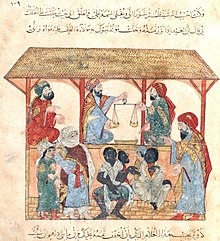art.wikisort.org - Artist
Yahya ibn Mahmud al-Wasiti (Arabic: يحيى بن محمود الواسطي) was a 13th-century Iraqi-Arab[1][2][3] painter and calligrapher, noted for his illustrations of al-Hariri's Maqamat.

Biography
Al-Wasiti was probably born in Wasit واسط south of Baghdad.[4] In 1237 he transcribed and illustrated a copy of al-Hariri's Maqamat typically shortened to Maqamat, and also known as the Assemblies,[5] a series of anecdotes of social satire written by Al-Hariri of Basra. Al-Wasiti's illustrations, which are among the finest examples of a style used in the 13th-century, served as an inspiration for the modern Baghdad art movement in the 20th-century.[6]
Very little is known about his life. He was from the 13th century school of painting. He was known for his articulate painting style.[7]
Illustrations from Maqamat
In total, Maqmat has 96 illustrations, all by al-Wasiti. They are of "outstanding quality with fine composition, expressive figures, and vivid but controlled colours" and provide readers with "fascinating series of glimpses into and commentaries on 13th-century Islāmic life."[8]
See also
- Arabic literature
- Culture of Iraq
- Islamic art
- List of Iraqi artists
References
- Makiya, Kanan (1991). The Monument: Art, Vulgarity, and Responsibility in Iraq. University of California Press. p. 92. ISBN 9780520073760.
Arab painter al wasiti.
- Ankori, Gannit (2013). Palestinian Art. Reaktion Books. ISBN 9781780232416.
- Explorers: Tales of Endurance and Exploration. Penguin. 2010. ISBN 9780756675110.
- Jonathan Bloom and Sheila S. Blair (eds), Grove Encyclopedia of Islamic Art & Architecture, Oxford University Press, 2009, p.210; Kember, P. (ed.), Benezit Dictionary of Asian Artists, Oxford University Press, 2012, ISBN 9780199923014
- Jonathan Bloom and Sheila S. Blair (eds), Grove Encyclopedia of Islamic Art & Architecture, Oxford University Press, 2009, p.294
- Wijdan, A. (ed.), Contemporary Art From The Islamic World, p.166
- "Yaḥyā ibn Maḥmūd al-Wāsiṭī," in: Encyclopædia Britannica, Online:
- "Yaḥyā ibn Maḥmūd al-Wāsiṭī," in: Encyclopædia Britannica, Online:
На других языках
- [en] Yahya ibn Mahmud al-Wasiti
[es] Yahya ibn Mahmud al-Wasiti
Yahya ibn Mahmud al-Wasiti (Árabe: يحيى بن محمود الواسطي) fue un pintor y calígrafo del S. XIII., nacido en Wasit, actual Irak. Se le considera el representante más destacado de la escuela de Bagdad. Su estilo, a la vez realista y estilizado, muestra influencias del arte turco y de los nativos cristianos. Es conocido por sus ilustraciones del Maqama de al-Hariri.[fr] Al-Wâsitî
Yahya ibn Mahmud al-Wâsitî' est un peintre et un calligraphe arabe du XIIIe siècle, actif à Bagdad. Il a notamment illustré un manuscrit des Maqamat de al-Hariri en 1237 (BNF, arabe 5847).[it] Yahya ibn Mahmud al-Wasiti
Yahya ibn Mahmud al-Wasiti (in arabo: يحيى بن محمود الواسطي; ... – ...; fl. XIII secolo) è stato un pittore e calligrafo iracheno del XIII secolo,[1][2][3] noto per le sue illustrazioni del Maqamat di al-Hariri.Другой контент может иметь иную лицензию. Перед использованием материалов сайта WikiSort.org внимательно изучите правила лицензирования конкретных элементов наполнения сайта.
WikiSort.org - проект по пересортировке и дополнению контента Википедии









